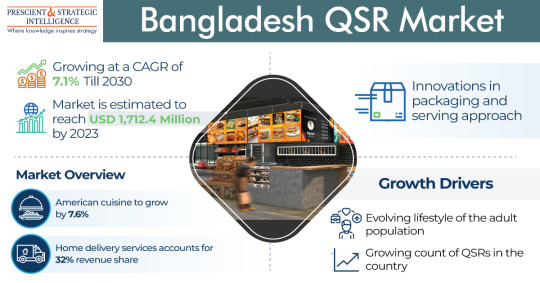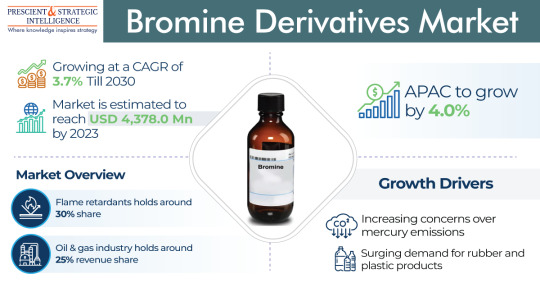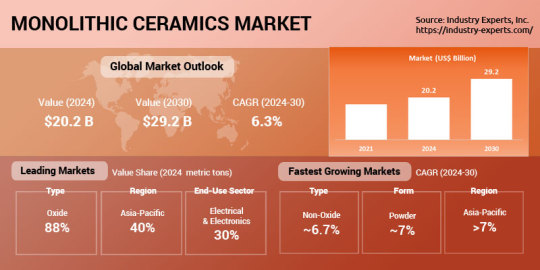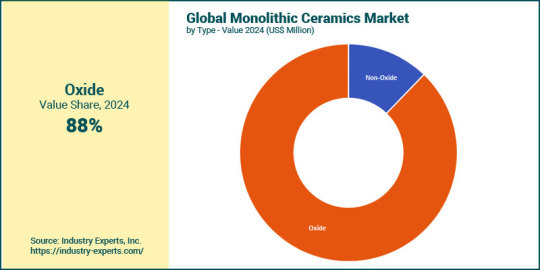#Industry Overview
Explore tagged Tumblr posts
Text
Bangladesh QSR Market Report: Trends, Analysis, and Growth Insights | P&S Intelligence
The value of the Bangladeshi quick-service restaurants market stood at USD 1,712.4 million in 2023, and this number is projected to reach USD 2,653.4 million by 2030, advancing at a CAGR of 7.1% during 2023–2030. This growth can be credited to the developing lifestyle of the adult populace, the increasing count of QSRs in the nation, the growing demand for fast food among the urban populace, and the rising working populace in the city and semi-urban areas of the country.

The demand for easy foods is increasing quickly among customers in Bangladesh, due to the parallel variations in the working and social lives and the mounting habit of dining out. People these days like to socialize over good food, away from the house. Therefore, because of the shortage of time, numerous contemporary nuclear families tend to choose convenient, quick meals over old-style meals.
American cuisine is likely to advance at the highest rate during this decade. This is because of the high requirement for fries, pizzas, and burgers among the young populace as well as the busy lifestyle of adults, which makes a requirement for convenience foods. Furthermore, other cuisines like Italian, Mexican, and Chinese, are also broadly prevalent among Bangladeshi citizens.
Moreover, the rising purchasing power of customers with their increasing per capita income, particularly in Dhaka, has boosted the sale of prepared food from QSRs in this nation. Bangladesh's economy is facing an era of low inflation, rising household income, and speedy progress.
As per the World Bank, Bangladesh has a purchasing power parity of 32.1 LCU per international dollar in 2021, in comparison to 16.3 LCU in 2002, advancing at a 3.63% average annual rate.
Furthermore, people, now, socialize with friends, neighbors, or colleagues, as compared to before for social or business purposes. This led to the increasing consumption of meals in fast food settings, which further boosted the industry.
#Bangladesh QSR Market#Market Report#P&S Intelligence#Fast Food Industry#Trends#Analysis#Growth Insights#Quick Service Restaurants#Market Dynamics#Food and Beverage Market#Market Research#Industry Overview#Competitive Analysis#Regional Analysis#QSR Market Size#Market Outlook#Dining Trends
2 notes
·
View notes
Text
Motor Lamination Market is Driven by Surging Vehicle Sales
The motor lamination market is estimated to touch USD 22.9 billion in 2023, which will increase to USD 32.0 billion, with a 4.9% compound annual growth rate, by 2030.
The progression of this industry is because of the rising sale of automobiles, particularly those employing electricity as the secondary or primary propulsion source, across the globe. Furthermore, automobile, as well as equipment safety standards, are increasing, which is further boosting the requirement for motor laminations.

Additionally, to reduce operational duration and decrease fabrication expenses, lamination sheets have experienced different variations with time. The significant advancement in lamination technologies to improve the performance of motors is essentially likely to boost the industry in the coming years.
The bonding category, based on technology, will propel at the fastest rate, of 5.3%, during this decade. This is because it removes the necessity for magnetic core rivet joints to lessen interlaminar loss.
To download free sample pages of this report@ https://www.psmarketresearch.com/market-analysis/motor-lamination-market-report/report-sample
Moreover, bonded cores don’t create hum sound, because of their exceptional thermal conductivity. Also, this technology is extensively employed because of its flexibility for personalized necessities.
Whereas, the welding category is also advancing at a significant rate, because of the employment of this procedure to manufacture strong and durable motors, by incorporating laminations together. Welding provides stronger efficiency, cost-effectiveness, and production to electric motors, the requirement for which is rising in practically every sector.
The silicon steel category, based on material type, is the largest contributor to the motor lamination market, with a 35% share. This is because it enhances the electrical resistivity, which means that it reduces the loss of current as well as decreases the conductivity.
The automotive category, based on industry, is the highest revenue contributor. This is because of the increasing need for comfortable and luxury automobiles with features like power steering & windows, retractable sunroofs, and HVAC equipment.
APAC is leading the industry, and it is further expected to remain leading, generating USD 10.3 billion, by 2030. This will be primarily because of the surge in the production of electric vehicles.
#Motor Lamination Market#Market Report#P&S Intelligence#Industry Trends#Analysis#Growth Forecasts#Market Dynamics#Electrical Motors#Lamination Materials#Global Motor Lamination Market#Market Research#Industry Overview#Competitive Analysis#Regional Analysis
0 notes
Text
Bromine Derivatives Market Report: Demand Analysis, and Growth Forecasts | P&S Intelligence
The bromine derivatives market was USD 4,378.0 million in 2023, which will rise to USD 5,614.1 million, powering at a 3.7% compound annual growth rate, by 2030.This is because of the extensive use of these chemicals in the pharmaceutical, construction, oil & gas, electronics, and automotive sectors, coupled with the growing requirement for plastic & rubber products. Moreover, the calcium bromide…

View On WordPress
#analysis#Bromine Derivatives Demand#Bromine Derivatives Market#Bromine Industry#Competitive Analysis#Global Bromine Derivatives Market#Growth Forecasts#Industry Overview#industry trends#Market dynamics#Market Insights#market outlook#Market Report#Market Research#P&S Intelligence#regional analysis
0 notes
Text
“What Oppenheimer Left Out”
Red Nation Podcast
This is a great history overview of the violence and exploitation of native folks under the mushroom cloud of USA settler colonialism, ecological “sacrifice zones”, and militarism.
#RedNationPodcast #Oppenheimer #Trinity #USHistory
#oppenheimer#whatoppenheimerleftout#podcast#rednation#history#overview#trinity#us history#exploitation#indigenous#military#military industrial complex#army#navy#air force#made in usa#usa news#usa#united states#unitedstateofamerica#unitedsnakes#amerika#americans#native american#america#colonization#colonialism#ecological#sacrifice#zones
52 notes
·
View notes
Text


I Also specialized in farmtoy model
#3d printing market analysis#3d printing market overview#3d printing market research#3d printing market share#3d printing market size#3d printing industry#3d printing materials#3d printing in healthcare#3d printing plastics market#3d printing
3 notes
·
View notes
Text


Ivry-sur-Seine, novembre 2024
#photography#photographie#photograph of tumblr#urban photography#france#paris#ivry#94#CREDAC#contemporary art center#factory#post industrial architecture#overview#cityscape#buildings#walls#memoria#memorabilia
2 notes
·
View notes
Text
Nurit Credit Card Processing Terminals: A Comprehensive Overview
#Nurit Credit Card Processing Terminals: A Comprehensive Overview#credit card processing#credit card terminal#credit#processing#nurit#credit card machine#credit card payments#card processing#emv credit card processing#exs credit card processing#accept credit cards#terminals#payment processing#credit card#best way to accept credit cards#credit card (industry)#free emv credit card terminal#process credit card payments#emv credit card terminal#cardpointe credit card terminal#credit card services
2 notes
·
View notes
Text
Future of the Industrial Lubricants Market: Innovations & Trends
Industrial Lubricants Market: Trends, Industry Analysis, Growth Factors
The Industrial Lubricants Market is expected to reach a value of USD 55.34 billion in 2023 and, with a linear growth pattern, reach USD 75.68 billion by 2033, with a compound annual growth rate (CAGR) of 3.8% from 2024 to 2033.
The Industrial Lubricants Market plays a vital role in various industries, ensuring the smooth operation of machinery and equipment. These lubricants help reduce friction, wear and tear, and overheating, thereby enhancing the efficiency and lifespan of industrial components. As industries continue to expand, the Industrial Lubricants Market Size is projected to grow steadily. This article provides an in-depth Industrial Lubricants Market Analysis, covering key trends, growth factors, challenges, and future opportunities.
Request Sample PDF Copy:https://wemarketresearch.com/reports/request-free-sample-pdf/industrial-lubricants-market/1356
Industrial Lubricants Market Segments
Market, By Type
Mineral oils
Synthetic oils
Bio-based oils
Market, By Application
Manufacturing
Transportation
Energy
Mining and construction
Food and beverage
Pharmaceutical
Others
Market, By Product
General industrial oils
Process oils
Metalworking fluids
Industrial engine oils
Industrial greases
Industrial Lubricants Market Trends and Analysis
Growing Demand for High-Performance Lubricants
One of the significant Industrial Lubricants Market Trends is the increasing demand for high-performance lubricants. These advanced lubricants offer superior protection, longer operational life, and enhanced efficiency in extreme conditions.
Expansion of the Manufacturing Sector
The rapid expansion of manufacturing industries worldwide is driving Industrial Lubricants Market Growth. As automation and heavy machinery usage increase, the need for efficient lubrication solutions is also rising.
Shift Towards Bio-Based Lubricants
Environmental concerns and regulatory pressures are encouraging industries to adopt eco-friendly alternatives. The rise of bio-based industrial lubricants is one of the major Industrial Lubricants Market Trends, reducing the carbon footprint while maintaining performance.
Digitalization and Smart Lubrication Systems
The integration of IoT and AI in lubrication systems is enhancing predictive maintenance. Smart lubricants and automated monitoring systems help industries optimize lubrication schedules, minimizing downtime and improving efficiency.
Industrial Lubricants Market Growth Factors
Increasing Industrialization and Urbanization
Rapid industrialization, especially in emerging economies, is driving the demand for lubricants. The growth of construction, automotive, and manufacturing industries directly contributes to Industrial Lubricants Market Growth.
Rising Demand from the Automotive Industry
The automotive sector is a major consumer of industrial lubricants. With increasing vehicle production and technological advancements, the demand for specialized lubricants is expected to rise.
Growing Energy and Power Sector
Industrial lubricants are essential in power generation, including wind, hydro, and thermal energy plants. The rising global energy demand is boosting Industrial Lubricants Market Potential.
Advancements in Lubricant Formulations
Ongoing research and development in synthetic and bio-based lubricants are leading to innovative products that enhance machinery efficiency, extend maintenance cycles, and reduce operational costs.
Key Companies in the Industrial Lubricants Market
ExxonMobil Corp
Fuchs Group
The Lubrizol Corporation
Royal Dutch Shell
Phillips 66
Lucas Oil Products, Inc.
Amsoil, Inc.
Bel-Ray Co., Inc.
Total S.A.
Kluber Lubrication
Valvoline International, Inc.
Chevron Corp.
Clariant
Quaker Chemical Corp.
Houghton International, Inc.
Castrol
Blaser Swisslube, Inc.
Calumet Specialty Products Partners, L.P.
Petronas Lubricant International
Idemitsu Kosan Co., Ltd.
Yushiro Chemical Industry Co., Ltd.
Key Points of the Industrial Lubricants Market Report
Comprehensive Industrial Lubricants Market Analysis covering trends, size, share, and forecast
Market segmentation based on product type, end-use industry, and application
Regional insights covering North America, Europe, Asia-Pacific, and Latin America
Key market players, competitive landscape, and strategic developments
Impact of regulations and environmental policies on the market
Benefits of This Report
Provides accurate Industrial Lubricants Market Forecast
Identifies key market drivers and challenges
Offers strategic insights for businesses and investors
Analyzes competitive landscape and key players in the industry
Helps stakeholders understand future market potential
Challenges in the Industrial Lubricants Market
Fluctuating Raw Material Prices
The Industrial Lubricants Market Price is influenced by the cost of raw materials such as base oils and additives. Price volatility poses challenges for manufacturers and consumers alike.
Stringent Environmental Regulations
Governments worldwide are implementing strict regulations regarding the use and disposal of industrial lubricants. Compliance with these regulations requires significant investments in research and development.
Increasing Competition from Alternative Technologies
The rise of self-lubricating materials and advanced coatings is posing a potential threat to the demand for traditional industrial lubricants.
Supply Chain Disruptions
Geopolitical tensions, trade restrictions, and global economic fluctuations can disrupt the supply chain, affecting Industrial Lubricants Market Share and availability.
Frequently Asked Questions (FAQs)
Q1: What is the current Industrial Lubricants Market Size?
Q2: Which industries drive Industrial Lubricants Market Growth?
Q3: What are the major Industrial Lubricants Market Trends?
Q4: How do environmental regulations impact the market?
Q5: What is the future Industrial Lubricants Market Forecast?
Related New Updated Research Report:
Antimicrobial-Coatings-Market
https://medium.com/@priteshwemarketresearch/antimicrobial-coatings-market-analysis-type-size-trends-key-players-and-forecast-2024-to-2034-f644d5e8f094
Heat-Transfer-Fluids-Market
https://medium.com/@priteshwemarketresearch/heat-transfer-fluids-market-industry-trends-and-forecast-to-2033-f6e6da647626
Global-Nanocomposites-Market
https://medium.com/@priteshwemarketresearch/global-nanocomposites-market-latest-trends-and-analysis-future-growth-study-by-2034-374bc36be5d6
Global-Green-Solvent-Market
https://medium.com/@priteshwemarketresearch/global-green-solvent-market-growth-trends-analysis-and-dynamic-demand-forecast-2024-to-2034-6cf30e39c8de
Industrial Lubricants Market:
https://wemarketresearch.com/reports/industrial-lubricants-market/1356
3D Printing Materials Market:
https://wemarketresearch.com/reports/3d-printing-materials-market/1338
Conclusion
The Industrial Lubricants Market is poised for significant growth, fueled by technological advancements, increasing industrialization, and rising demand from key industries. While Industrial Lubricants Market Challenges such as regulatory restrictions and raw material price fluctuations exist, the industry offers substantial opportunities for innovation and expansion.
#Industrial lubricants#Industrial lubricants Market#Industrial lubricants Market Scope#Industrial lubricants Market Growth#Industrial lubricants Market Overview#Industrial lubricants Market Size#Industrial lubricants Market Insight#Industrial lubricants Market Trends#Industrial lubricants Market Share#Industrial lubricants Market Industry Analysis
0 notes
Text
APAC Solar Street Lighting Market Will Advance at a 16.4% CAGR
The APAC solar street lighting market was USD 2,315.9 million in 2023, which will rise to USD 6,691.2 million, advancing at a 16.4% CAGR, by 2030.
A key trend observed in this industry is the increasing acceptance of smart solar streetlights. Moreover, smart lighting systems are power-effective because they employ LED lights and offer distinctive sensors and control units in every lamp, which allow data communication to central controlling systems.

The centralized category, on the basis of structure type, led the industry. This can be because of the increasing on-grid based solar streetlight disposition that gets a constant electric source from a grid to fuel lights at a great illumination.
The solar panel category, based on component, was the largest contributor to the APAC solar street lighting market in 2023, with a 35% share. This can be because it is essential for the operation of entire street lighting via renewable energy.
The lamp category, on the other hand, will advance at the fastest compound annual growth rate in the coming years. This is mainly because of the increasing acceptance of LEDs in solar streetlights. The increasing emphasis on adopting LEDs is because of the rising government proposals in nations, such as China and India, for the acceptance of energy-effective LED lights.
China led the industry, and it is likely to advance at a 17.0% compound annual growth rate, in the coming years. This can be mainly because of the continuing building of several highways, streets, flyovers, and airports; and the increasing urbanization.
With the growing number of smart cities in this region, the APAC solar street lighting industry will advance continuously in the coming years.
#APAC Solar Street Lighting Market#Market Report#P&S Intelligence#Renewable Energy#Trends#Analysis#Growth Forecasts#Solar Lighting Solutions#Market Dynamics#Asia-Pacific Solar Market#Market Research#Industry Overview#Competitive Analysis#Regional Analysis#Solar Street Light Manufacturers#Market Outlook
0 notes
Text
https://heyjinni.com/read-blog/197096_industrial-rubber-products-market-size-trends-and-forecast-2023-to-2032.html
#Industrial Rubber Products Market Share#Industrial Rubber Products Market Overview#Industrial Rubber Products Market Growth
0 notes
Text
Cross-Linked Polyethylene Market Report: Trends Analysis, and Growth Forecasts | P&S Intelligence
The cross-linked polyethylene market is anticipated to achieve a revenue of USD 7,544.8 million by the conclusion of 2023. It is projected to experience a compound annual growth rate (CAGR) of 7.7% from 2024 to 2030, reaching a total of USD 12,587.5 million by 2030. During the projection period, the automotive is projected to be the fastest-growing category, with a CAGR of 8.0%, on the basis of…

View On WordPress
#analysis#Competitive Analysis#Cross-Linked Polyethylene Demand#Cross-Linked Polyethylene Market#Global Cross-Linked Polyethylene Market#Growth Forecasts#Industry Overview#industry trends#Market dynamics#Market Insights#market outlook#Market Report#Market Research#P&S Intelligence#Polyethylene Industry#regional analysis
0 notes
Photo




(via Global Monolithic Ceramics Market Size, Outlook 2024-2030)
#monolithic ceramics market overview#global monolithic ceramics industry#monolithic ceramics applications#monolithic ceramics in automotive industry#monolithic ceramics in electronics#monolithic ceramics in defense sector#monolithic ceramics market trends
0 notes
Text
Stay updated with the latest trends in the German automotive market and use FOXX to explore opportunities and strategies. Get essential market intelligence to boost your business in Finland and beyond.
#automotive suppliers in germany#german automotive market#automotive suppliers germany#market explorer#market study russia#german automotive industry overview
0 notes
Text
The Future of Flight Safety: How Aircraft Health Monitoring Systems Are Shaping the Aviation Market
The global Aircraft Health Monitoring Systems market is projected to grow at a compound annual growth rate (CAGR) of 6% over the forecast period, reflecting rising demand for enhanced safety and operational efficiency in aviation.
Market Overview: The Aircraft Health Monitoring System (AHMS) market is witnessing significant growth as airlines and aviation companies increasingly adopt advanced monitoring solutions to ensure aircraft safety, reduce downtime, and optimize maintenance costs. AHMS plays a critical role in monitoring various aircraft components such as engines, airframes, and avionics to predict and prevent failures. This technology supports proactive maintenance and helps operators improve flight efficiency while ensuring passenger safety.
Key Trends: Rise in Demand for Predictive Maintenance: Airlines and operators are shifting from traditional reactive maintenance practices to predictive maintenance, using AHMS to foresee potential failures before they occur. This helps in reducing unexpected costs and improving aircraft uptime.
Integration of IoT and Big Data: The adoption of IoT sensors and the integration of big data analytics are transforming AHMS. These technologies enable real-time data collection from various components, leading to more accurate diagnostics and performance monitoring.
Emergence of AI and Machine Learning: Artificial intelligence and machine learning algorithms are enhancing AHMS capabilities by analyzing complex data patterns and offering insights that help in more accurate failure predictions and optimization of maintenance schedules.
Growing Focus on Sustainability: With increasing pressure to reduce carbon emissions, AHMS systems are aiding in fuel efficiency optimization, thereby helping operators minimize their environmental footprint by detecting inefficiencies in aircraft systems.
Rise in Aircraft Fleet and Air Travel Demand: The recovery of the aviation industry post-pandemic and the increase in global air travel are driving the demand for newer, safer, and more efficient aircraft. This directly correlates with the adoption of sophisticated health monitoring systems.
Challenges: High Implementation Costs: The initial investment in AHMS infrastructure, sensors, and data processing systems can be high, particularly for smaller airlines and operators with limited budgets.
Data Security Concerns: With the collection and transmission of sensitive operational data, maintaining data privacy and ensuring robust cybersecurity measures are critical challenges for AHMS providers and aviation companies.
Integration Complexity: Integrating AHMS with existing aircraft systems and legacy technologies can be complex, requiring significant time and expertise to ensure seamless operation.
Regulatory and Compliance Barriers: Adhering to strict aviation industry regulations and standards for aircraft safety can slow down the widespread adoption of AHMS solutions, particularly in new or evolving markets.
Conclusion: The Aircraft Health Monitoring Systems market is poised for steady growth, driven by advancements in predictive maintenance, IoT integration, and the increasing demand for safer, more efficient aviation operations. However, challenges such as high initial costs, data security concerns, and regulatory compliance must be addressed to fully realize the potential of these technologies. As the market matures, AHMS will play a pivotal role in transforming the aviation landscape, enhancing flight safety, and optimizing operational efficiency.
#Aircraft Health Monitoring Systems market#Aircraft Health Monitoring Systems market size#Aircraft Health Monitoring Systems market share#Aircraft Health Monitoring Systems industry#Aircraft Health Monitoring Systems industry overview
0 notes
Text
The research insight on the kombucha industry highlights the prominent players in the market. Get known & unknown adjacencies impacting the market for kombucha.
#Kombucha Market#Kombucha#Kombucha Market Size#Kombucha Market Share#Kombucha Market Growth#Kombucha Market Trends#Kombucha Market Forecast#Kombucha Market Analysis#Kombucha Market Report#Kombucha Market Scope#Kombucha Market Overview#Kombucha Market Outlook#Kombucha Market Drivers#Kombucha Industry#Kombucha Companies
0 notes
Text
Panniculitis Market Size, Share, and Trends Analysis Report – Industry Overview and Forecast to 2032 CAGR, Growth, Share, Value, Size, Analysis
"Panniculitis Market Size And Forecast by 2032
According to Data Bridge Market Research The global panniculitis market size was valued at USD 97.79 billion in 2024 and is projected to reach USD 208.25 billion by 2032, with a CAGR of 9.91% during the forecast period of 2025 to 2032.
Our comprehensive Panniculitis Market report is ready with the latest trends, growth opportunities, and strategic analysis. https://www.databridgemarketresearch.com/reports/global-panniculitis-market
**Segments**
- **By Type**: The panniculitis market can be segmented by type into septal panniculitis, lobular panniculitis, mixed panniculitis, and others. Each type may require different treatment approaches and medications, leading to specific market demands for each category.
- **By Treatment**: Segmentation by treatment can include medication therapy, immunosuppressive therapy, surgery, and others. The choice of treatment can vary based on the severity of the condition, patient response, and potential side effects, impacting the market for each treatment option.
- **By End-User**: The market can also be segmented by end-user, with categories such as hospitals, specialty clinics, ambulatory surgical centers, and others. Understanding where most patients seek treatment can help stakeholders tailor their services and products to better reach their target audience.
**Market Players**
- **Pfizer Inc.**: A key player in the panniculitis market, Pfizer Inc. offers a range of medications and therapies for treating different types of panniculitis, contributing to a significant market share.
- **Novartis AG**: Novartis AG is another prominent player in the market, known for its innovative treatments and research in various therapeutic areas, including panniculitis.
- **AbbVie Inc.**: AbbVie Inc. is actively involved in developing advanced treatments for panniculitis, focusing on improving patient outcomes and expanding its market presence.
- **GlaxoSmithKline plc**: With a diverse portfolio of pharmaceutical products, GlaxoSmithKline plc plays a vital role in the panniculitis market by providing effective treatment options and therapies.
- **Johnson & Johnson Services, Inc.**: Johnson & Johnson Services, Inc. is a global leader in healthcare, offering a comprehensive range of solutions for panniculitis management and care.
The panniculitis market is a dynamic industry with various segments and players contributing to its growth and innovation. As research advances and new treatments emerge, the market continues to evolve, providing better options for patients and healthcare providers alike. To stay informed about the latest trends and developments in the global panniculitis market, visit https://www.databridgemarketresearch.com/reports/global-panniculitis-market The panniculitis market is experiencing significant growth and evolution due to the rise in research and development activities focusing on innovative treatment options for different types of panniculitis. The segmentation by type, including septal panniculitis, lobular panniculitis, mixed panniculitis, and others, allows for a more tailored approach to treatment, leading to specific market demands for each category. This segmentation helps healthcare providers and pharmaceutical companies develop targeted therapies that address the unique challenges associated with each type of panniculitis, thereby driving market growth and improving patient outcomes.
Segmentation by treatment further enhances the market dynamics by offering a diversified range of treatment options such as medication therapy, immunosuppressive therapy, surgery, and others. The availability of various treatment modalities enables healthcare providers to personalize treatment plans based on individual patient needs, disease severity, and potential side effects. This personalized approach not only improves patient satisfaction but also creates opportunities for market players to introduce novel therapies and expand their market presence by addressing unmet medical needs in the panniculitis space.
Additionally, segmenting the market by end-user categories such as hospitals, specialty clinics, and ambulatory surgical centers provides valuable insights into where patients seek treatment and healthcare services. Understanding the preferences of end-users helps stakeholders optimize their product offerings and marketing strategies to effectively target and engage with their audience. For instance, pharmaceutical companies can collaborate with key end-users to promote awareness about panniculitis treatments and enhance patient access to innovative therapies, contributing to the overall growth and development of the market.
Key players such as Pfizer Inc., Novartis AG, AbbVie Inc., GlaxoSmithKline plc, and Johnson & Johnson Services, Inc. are instrumental in driving market innovation and advancements through their robust research and development initiatives. These companies play a crucial role in developing cutting-edge treatments, expanding market reach, and improving patient outcomes in the panniculitis market. By investing in novel therapies, strategic partnerships, and market expansion strategies, these players contribute to the overall growth and sustainability of the panniculitis market, paving the way for future advancements and breakthroughs in the field.
In conclusion, the panniculitis market is a dynamic and competitive industry characterized by numerous segments and key players driving innovation and growth. With a focus on personalized treatment approaches, diverse treatment options, and targeted marketing strategies, the market is poised for continuous expansion and evolution. Stay updated on the latest trends and developments in the global panniculitis market by visiting reputable sources and research platforms to gain valuable insights into market dynamics and emerging opportunities.**Segments**
Global Panniculitis Market Segmentation includes different types such as Lobular panniculitis, Septal panniculitis, and Panniculitis associated with vasculitis. The varying types of panniculitis require specific treatment approaches. In terms of treatment options, the market segmentation covers Antibiotics, Corticosteroids, Non-steroidal anti-inflammatory drugs (NSAIDS), Immunosuppressants, Surgery, and other therapeutic interventions. The diagnosis segment comprises Blood Tests, Throat Swab, Chest X-ray, CT scans, Biopsy, and other diagnostic tools. Moreover, dosage forms may include tablets, injections, and other administration methods. The route of administration can be oral, intravenous, or other specialized routes. End-users in this market can range from clinics, hospitals to other healthcare facilities. Distribution channels encompass hospital pharmacies, retail pharmacies, and online pharmacies. This comprehensive segmentation provides a detailed overview of the multifaceted panniculitis market landscape and sets the stage for analyzing industry trends and forecasting future developments up to 2032.
**Market Players**
Leading players in the panniculitis market include AbbVie Inc. (U.S.), Merck & Co., Inc. (U.S.), Pfizer Inc. (U.S.), GSK plc (U.K.), Paratek Pharmaceuticals, Inc. (U.S.), Abbott (U.S.), F. Hoffmann-La Roche Ltd. (Switzerland), Viatris Inc. (U.S.), Teva Pharmaceutical Industries Ltd. (Israel), Sanofi (France), Novartis AG (Switzerland), Bayer AG (Germany), Sun Pharmaceutical Industries Ltd. (India), Eli Lilly and Company (U.S.), Aurobindo Pharma (India), Lupin (India), AstraZeneca (U.K.), Johnson & Johnson Private Limited (U.S.), Sumitomo Corporation (Japan), Merck KGaA (Germany), LEO Pharma A/S (Denmark), Cipla (India), Bristol-Myers Squibb Company (U.S.), and Astellas Pharma Inc. (Japan). These key market players are at the forefront of research, development, and commercialization of panniculitis treatments, driving innovation and growth in the industry.
The global panniculitis market is witnessing remarkable growth due to the continuous influx of research and development initiatives focusing on novel treatment options for various types of panniculitis. The increasing segmentation in terms of different types, treatments, diagnosis methods, dosage forms, administration routes, end-users, and distribution channels allows for a more targeted and personalized approach to managing this complex condition. With a diverse range of market players contributing their expertise and resources, the panniculitis market is poised for significant advancements and expansion in the coming years.
Moreover, the presence of established pharmaceutical companies like Pfizer Inc., Novartis AG, and AbbVie Inc., alongside emerging players such as Paratek Pharmaceuticals, Inc. and Viatris Inc., indicates a robust competitive landscape driving innovation and competitiveness in the market. These companies are not only investing in developing cutting-edge therapies but also in forging strategic partnerships and collaborations to enhance their market presence and cater to the evolving needs of patients with panniculitis.
In conclusion, the global panniculitis market's segmentation by various parameters and the active involvement of key market players underscore a dynamic and growing industry landscape. The constant evolution of treatment options, diagnostic tools, and distribution channels, coupled with the intense research and development activities by market leaders, promises a future where panniculitis patients have access to advanced, effective, and personalized care options. By staying abreast of industry trends and advancements, stakeholders can leverage opportunities in this burgeoning market to address unmet medical needs and improve patient outcomes significantly.
The market is highly fragmented, with a mix of global and regional players competing for market share. To Learn More About the Global Trends Impacting the Future of Top 10 Companies in Panniculitis Market : https://www.databridgemarketresearch.com/reports/global-panniculitis-market/companies
Key Questions Answered by the Global Panniculitis Market Report:
What is the current state of the Panniculitis Market, and how has it evolved?
What are the key drivers behind the growth of the Panniculitis Market?
What challenges and barriers do businesses in the Panniculitis Market face?
How are technological innovations impacting the Panniculitis Market?
What emerging trends and opportunities should businesses be aware of in the Panniculitis Market?
Browse More Reports:
https://www.databridgemarketresearch.com/reports/global-shower-enclosure-and-cubicles-markethttps://www.databridgemarketresearch.com/reports/global-mucociliary-clearance-and-dysfunction-treatment-markethttps://www.databridgemarketresearch.com/reports/global-neuropathic-pain-markethttps://www.databridgemarketresearch.com/reports/global-electrical-insulation-coating-markethttps://www.databridgemarketresearch.com/reports/global-multi-touch-screen-market
Data Bridge Market Research:
☎ Contact Us:
Data Bridge Market Research
US: +1 614 591 3140
UK: +44 845 154 9652
APAC: +653 1251 982
✉ Email: [email protected]"
#Panniculitis Market Size#Share#and Trends Analysis Report – Industry Overview and Forecast to 2032 CAGR#Growth#Value#Size#Analysis
0 notes